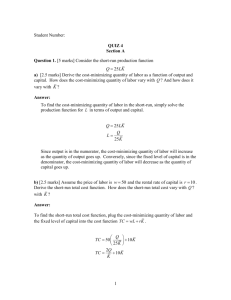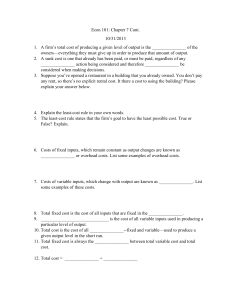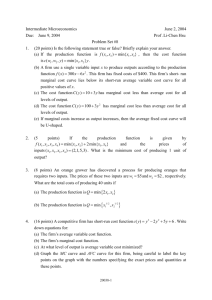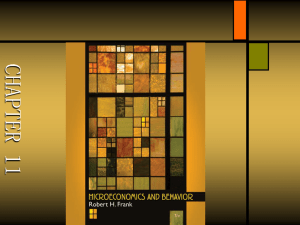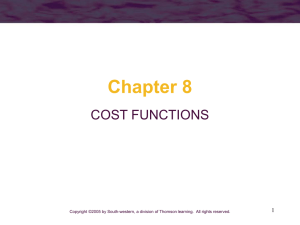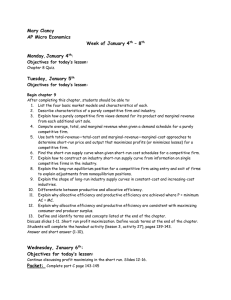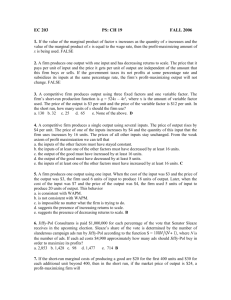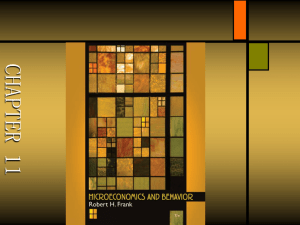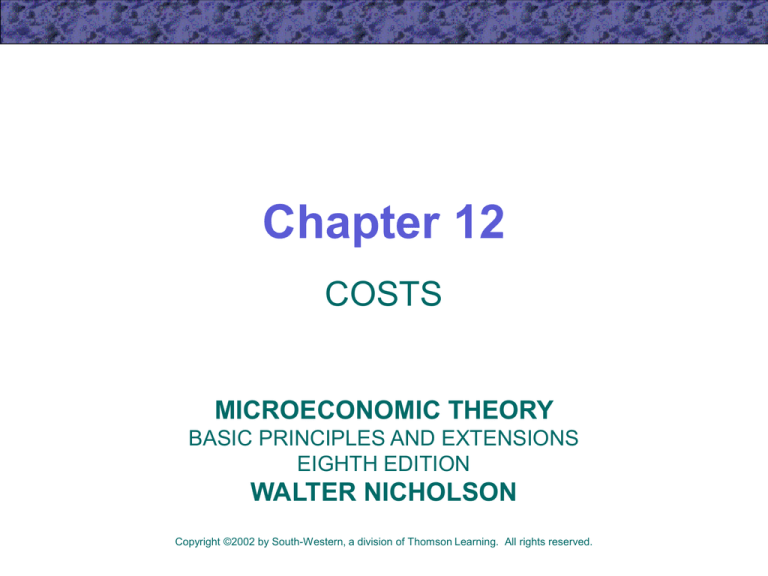
Chapter 12
COSTS
MICROECONOMIC THEORY
BASIC PRINCIPLES AND EXTENSIONS
EIGHTH EDITION
WALTER NICHOLSON
Copyright ©2002 by South-Western, a division of Thomson Learning. All rights reserved.
Definitions of Costs
• It is important to differentiate between
accounting cost and economic cost
– the accountant’s view of cost stresses outof-pocket expenses, historical costs,
depreciation, and other bookkeeping
entries
– economists focus more on opportunity cost
Definitions of Costs
• Labor Costs
– to accountants, expenditures on labor are
current expenses and hence costs of
production
– to economists, labor is an explicit cost
• labor services are contracted at some hourly
wage (w) and it is assumed that this is also
what the labor could earn in alternative
employment
Definitions of Costs
• Capital Costs
– accountants use the historical price of the
capital and apply some depreciation rule to
determine current costs
– economists refer to the capital’s original price
as a “sunk cost” and instead regard the
implicit cost of the capital to be what
someone else would be willing to pay for its
use
• we will use v to denote the rental rate for capital
Definitions of Costs
• Costs of Entrepreneurial Services
– To an accountant, the owner of a firm is
entitled to all profits, which are the revenues
or losses left over after paying all input costs
– Economists consider the opportunity costs of
time and funds that owners devote to the
operation of their firms
• these services are inputs and some cost should
be imputed to them
• part of accounting profits would be considered as
entrepreneurial costs by economists
Economic Cost
• The economic cost of any input is the
payment required to keep that input in
its present employment
– the remuneration the input would receive in
its best alternative employment
Two Simplifying Assumptions
• There are only two inputs
– homogeneous labor (L), measured in laborhours
– homogeneous capital (K), measured in
machine-hours
• entrepreneurial costs are included in capital costs
• Inputs are hired in perfectly competitive
markets
– firms are price takers in input markets
Economic Profits
• Total costs for the firm are given by
total costs = TC = wL + vK
• Total revenue for the firm is given by
total revenue = Pq = Pf(K,L)
• Economic profits () are equal to
= total revenue - total cost
= Pq - wL - vK
= Pf(K,L) - wL - vK
Economic Profits
• Economic profits are a function of the
amount of capital and labor employed
– we could examine how a firm would choose
K and L to maximize profit
• “derived demand” theory of labor and capital
inputs (see Chapter 21)
• But for now we will assume that the firm
has already chosen its output level (q0)
and wants to minimize its costs
Cost-Minimizing Input Choices
• To minimize the cost of producing a
given level of output, a firm should
choose a point on the isoquant at which
the RTS is equal to the ratio w/v
– it should equate the rate at which K can be
traded for L in the productive process to
the rate at which they can be traded in the
marketplace
Cost-Minimizing Input Choices
• Mathematically, we seek to minimize
total costs given q = f(K,L) = q0
• Setting up the Lagrangian
L = wL + vK + [q0 - f(K,L)]
• First order conditions are
L/L = w - (f/L) = 0
L/K = v - (f/K) = 0
L/ = q0 - f(K,L) = 0
Cost-Minimizing Input Choices
• Dividing the first two conditions we get
w f / L
RTS (L for K )
v f / K
• The cost-minimizing firm should equate
the RTS for the two inputs to the ratio of
their prices
Cost-Minimizing Input Choices
Given output q0, we wish to find the least
costly point on the isoquant
K per period
TC1
TC3
Costs are represented by
parallel lines with a slope
of -w/v
TC2
TC1 < TC2 < TC3
q0
L per period
Cost-Minimizing Input Choices
The minimum cost of producing q0 is TC2
This occurs at the
tangency between the
isoquant and the total
cost curve
K per period
TC1
TC3
TC2
K*
q0
L*
The optimal
choice is L*, K*
L per period
Output Maximization
• The dual formulation of the firm’s cost
minimization problem is to maximize
output for a given level of cost
• The Lagrangian is
L = f(K,L) + D(TC1 - wL - vK)
• The first-order conditions are identical to
those for the primal problem
Output Maximization
The maximum output attainable with total
cost TC2 is q0
This occurs at the
K per period
tangency between the
total cost curve and
isoquant q0
TC2 = wL + vK
K*
q1
q0
The optimal
choice is L*, K*
q00
L*
L per period
Derived Demand
• In Chapter 5, we considered how the
utility-maximizing choice is affected by
the change in the price of a good
– we used this technique to develop the
demand curve for a good
• Can we develop a firm’s demand for an
input in the same way?
Derived Demand
• To analyze what happens to K* if v
changes, we must know what happens to
the output level chosen by the firm
• The demand for K is a derived demand
– it is based on the level of the firm’s output
• We cannot answer questions about K*
without looking at the interaction of supply
and demand in the output market
The Firm’s Expansion Path
• The firm can determine the costminimizing combinations of K and L for
every level of output
• If input costs remain constant for all
amounts of K and L the firm may
demand, we can trace the locus of costminimizing choices
– called the firm’s expansion path
The Firm’s Expansion Path
The expansion path is the locus of costminimizing tangencies
The curve shows
how inputs increase
as output increases
K per period
E
q1
q0
q00
L per period
The Firm’s Expansion Path
• The expansion path does not have to be
a straight line
– some inputs may increase faster than others
as output expands
• depends on the shape of the isoquants
• The expansion path does not have to be
upward sloping
– if the use of an input falls as output expands,
that input is an inferior input
Minimizing Costs for a
Cobb-Douglas Function
• Suppose that the production function for
hamburgers is
q = 10K 0.5 L 0.5
• Total costs are given by
TC = vK + wL
• Suppose that the firm wishes to minimize
the cost of producing 40 hamburgers
Minimizing Costs for a
Cobb-Douglas Function
• The Lagrangian expression is
L = vK + wL + (40 - 10K 0.5 L 0.5)
• The first-order conditions are
L/K = v - 5(L/K)0.5 = 0
L/L = w - 5(K/L)0.5 = 0
L/ = 40 - 10K 0.5 L 0.5 = 0
Minimizing Costs for a
Cobb-Douglas Function
• Dividing the first equation by the second
gives us
w K
RTS
v L
• This production function exhibits constant
returns to scale so the expansion path is
a straight line
Total Cost Function
• The total cost function shows that for
any set of input costs and for any output
level, the minimum cost incurred by the
firm is
TC = TC(v,w,q)
• As output increases, total costs
increase
Average Cost Function
• The average cost function (AC) is found
by computing total costs per unit of
output
TC(v ,w, q )
average cost AC(v ,w, q )
q
Marginal Cost Function
• The marginal cost function (MC) is
found by computing the change in total
costs for a change in output produced
TC(v ,w, q )
marginal cost MC(v ,w, q )
q
Graphical Analysis of
Total Costs
• Suppose that K1 units of capital and L1
units of labor input are required to
produce one unit of output
TC(q=1) = vK1 + wL1
• To produce m units of output
TC(q=m) = vmK1 + wmL1 = m(vK1 + wL1)
TC(q=m) = m TC(q=1)
• TC is proportional to q
Graphical Analysis of
Total Costs
Total
costs
Total costs are proportional to output
AC = MC
TC
Both AC and
MC will be
constant
Output
Graphical Analysis of
Total Costs
• Suppose instead that total costs start
out as concave and then becomes
convex as output increases
– one possible explanation for this is that
there is another factor of production that is
fixed as capital and labor usage expands
– total costs begin rising rapidly after
diminishing returns set in
Graphical Analysis of
Total Costs
Total
costs
TC
Total costs rise
dramatically as
output rises
after diminishing
returns set in
Output
Graphical Analysis of
Total Costs
Average
and
marginal
costs
MC is the slope of the TC curve
MC
AC
min AC
If AC > MC,
AC must be
falling
If AC < MC,
AC must be
rising
Output
Shifts in Cost Curves
• The cost curves are drawn under the
assumption that input prices and the
level of technology are held constant
– any change in these factors will cause the
cost curves to shift
Homogeneity
• The total cost function is homogeneous
of degree one in input prices
– if all input prices were to increase in the
same proportion (t), the total costs for
producing any given output level would also
be multiplied by t
– a simultaneous increase in input prices does
not change the ratio of input prices
• cost-minimizing combination of K and L
unchanged
Homogeneity
• The average and marginal cost functions
will also be homogeneous of degree one
in input prices
• In a “pure” inflationary period (one where
the prices of all inputs rise at the same
rate), there will be no incentive for firms
to alter their input choices
Change in the Price
of One Input
• If the price of only one input changes,
the firm’s cost-minimizing choice of
inputs will be affected
– a new expansion path must be derived
Change in the Price
of One Input
• An increase in the price of one input
must increase TC for any output level
• AC will also rise
• If the input is not inferior, MC will also
rise
Change in the Price
of One Input
• A change in the price of an input means
that the firm must alter its cost-minimizing
choice of inputs
– in the two-input case, an increase in w/v will
be met by an increase in K/L
• Define the elasticity of substitution as
(K / L) w / v ln( K / L)
s
(w / v ) K / L ln( w / v )
– s must be nonnegative
Size of Shifts in Costs Curves
• The increase in costs will be largely
influenced by the relative significance of
the input in the production process
• If firms can easily substitute another
input for the one that has risen in price,
there may be little increase in costs
Cobb-Douglas Cost Function
• Suppose that the production function is
q = 10K 0.5L0.5
• First-order conditions for cost
minimization require that
w/v = K/L
• Dividing by K yields
q/k = 10(v/w)0.5
Cobb-Douglas Cost Function
• This means that
K = (q/10)w 0.5v -0.5
• Multiplying both sides by v, we get
vK = (q/10)w 0.5v 0.5
• A similar chain of substitutions yields
wL = (q/10)w 0.5v 0.5
Cobb-Douglas Cost Function
• Because
TC = vK + wL
we have
TC = (2/10)qw 0.5v 0.5
• If w = v = $4, then
TC = 0.8q
Cobb-Douglas Cost Function
• Because the production function
exhibits constant returns to scale, AC
and MC will be constant
AC = TC/q = 0.8
MC = TC/q = 0.8
• If v rises to $9, TC, AC, and MC rise
TC = (2/10)qw 0.5v 0.5 = 1.2q
AC = TC/q = 1.2
MC = TC/q = 1.2
Short-Run, Long-Run
Distinction
• In the short run, economic actors have
only limited flexibility in their actions
• Assume that the capital input is held
constant at K1 and the firm is free to
vary only its labor input
• The production function becomes
q = f(K1,L)
Short-Run Total Costs
• Short-run total cost for the firm is
STC = vK1 + wL
• There are two types of short-run costs:
– short-run fixed costs (SFC) are costs
associated with fixed inputs
– short-run variable costs (SVC) are costs
associated with variable inputs
Short-Run Total Costs
• Short-run costs are not minimal costs
for producing the various output levels
– the firm does not have the flexibility of input
choice
– to vary its output in the short run, the firm
must use nonoptimal input combinations
– the RTS will not be equal to the ratio of
input prices
Short-Run Total Costs
K per period
Because capital is fixed at K1,
the firm cannot equate RTS
with the ratio of input prices
K1
q2
q1
q0
L per period
L1
L2
L3
Short-Run Marginal and
Average Costs
• The short-run average total cost (SATC)
function is
SATC = total costs/total output = STC/q
• The short-run marginal cost (SMC) function
is
SMC = change in STC/change in output = STC/q
Short-Run Average Fixed
and Variable Costs
• Short-run average fixed costs (SAFC) are
SAFC = total fixed costs/total output = SFC/q
• Short-run average variable costs are
SAVC = total variable costs/total output = SVC/q
Relationship between ShortRun and Long-Run Costs
STC (K2)
Total
costs
STC (K1)
TC
The long-run
TC curve can
be derived by
varying the
level of K
STC (K0)
q0
q1
q2
Output
Relationship between ShortRun and Long-Run Costs
Costs
SMC (K0)
SATC (K0)
MC
AC
SMC (K1)
q0
q1
SATC (K1)
The geometric
relationship
between shortrun and long-run
AC and MC can
also be shown
Output
Relationship between ShortRun and Long-Run Costs
• At the minimum point of the AC curve:
– the MC curve crosses the AC curve
• MC = AC at this point
– the SATC curve is tangent to the AC curve
• SATC (for this level of K) is minimized at the same
level of output as AC
• SMC intersects SATC also at this point
– the following are all equal:
AC = MC = SATC = SMC
Important Points to Note:
• A firm that wishes to minimize the
economic costs of producing a particular
level of output should choose that input
combination for which the rate of
technical substitution (RTS) is equal to
the ratio of the inputs’ rental prices
Important Points to Note:
• Repeated application of this minimization
procedure yields the firm’s expansion path
– the expansion path shows how input usage
expands with the level of output
• The relationship between output level and
total cost is summarized by the total cost
function [TC(q,v,w)]
– the firm’s average cost (AC = TC/q) and
marginal cost (MC = TC/q) can be derived
directly from the total cost function
Important Points to Note:
• All cost curves are drawn on the
assumption that the input prices and
technology are held constant
– when an input price changes, cost curves
shift to new positions
• the size of the shifts will be determined by the
overall importance of the input and by the ease
with which the firm may substitute one input for
another
– technical progress will also shift cost curves
Important Points to Note:
• In the short run, the firm may not be able
to vary some inputs
– it can then alter its level of production only by
changing the employment of its variable
inputs
– it may have to use nonoptimal, higher-cost
input combinations than it would choose if it
were possible to vary all inputs

